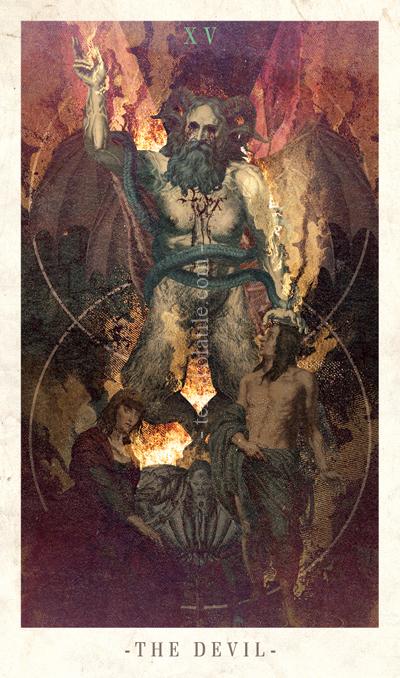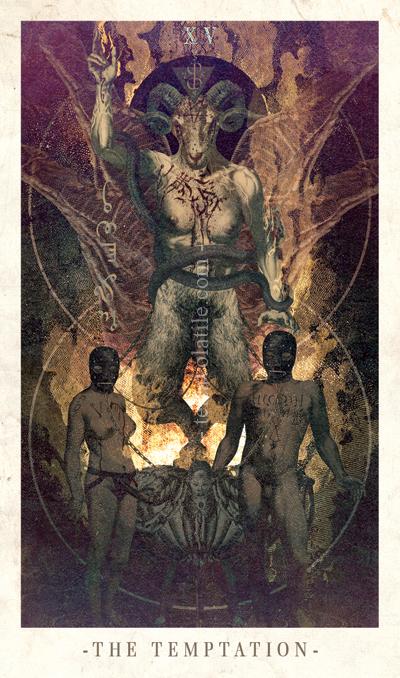
Symbology
The Devil has an especially bad connotation in religious context since he was created by many religions as a scapegoat for all the dreadful things that happen to humans.
Mythologically speaking we can admit the visual influence of Pan, god of nature and wilderness. Unlike the Olympian gods, Pan lived on Earth and developed some attributes related to sexuality and fertility. His typical goat-like features recall the most conventional depictions of the Devil, and that fact could be related to the neopagan cults often associated with witchcraft.
The image of Pan that survived all these centuries as a god of fertility on Earth was considered by the Christians as a terrifying manifestation of Satan; and the women that worshiped him were brutally hunted. Pan’s earthly aspects moved him away from the sacred aspects of Christianity and he turned into an icon for our sinful desires.
Regarding this card, The Devil represents all these urges of carnal nature to an extreme and the temptation to choose the material over the spiritual. It generally refers to the sense of being trapped or restricted and to fall into addiction, many times because of the outside forces that influence and manipulate you.
The Devil suggests some balance due to his hermaphroditical elements and the position of his hands (resembling The Magician): one facing up and another one facing down. However, all of that is a lie, an illusion, which is one the characteristics of the card.
He is a great deceiver with a lot of “tongue and hand”. At his feet we can observe two submissive characters. These are the figures from The Lovers who are portrayed with no chains or ropes restraining them, meaning that they still have control over their lives but chose to follow this way. About this, it is interesting to note that the fifteen that numbers the car, when reduced to six (1+5), reveals the card of The Lovers and how they were corrupted by tempting promises.
In Buddhism, Mara is a demonic celestial king who tempted Siddhartha (Buddha) with the vision of beautiful women and dragged him away from achieving enlightenment. He personifies the Sin, the unwholesome impulses and temptations and the antagonistic forces to a virtuous spiritual life. This concept is directly linked to The Devil as a warning against these negative influences that can appear in our lives.
Some authors mention the Devil as a manifestation of the Freudian “Id”. If we fail to dominate our infantile and immature impulses with reason, that might drive us into an environment of antagonism and dogma, as well as some kind of tyranny.
This arcanum is meant to symbolise the idea of stagnation, which is often visible in material life as a feeling of complete frustration and a barrier to spiritual freedom and moral development.
In the Osho tarot we can see how this card (called Conditioning) pertains to a set of beliefs that move us away from our true and radiant state of being.
Some theories connect this tarot card to Baphomet. Despite the visual similarities, we think that is a wrong association. Baphomet has a long story of misunderstanding along the centuries and his aspect is an actual representation developed by the French occultist Eliphas Lévi. This expert gave sacred marks to the creature – Lévi’s Baphomet was originally created as a symbol of cosmic balance and a pantheistic manifestation of magic; and has nothing to do directly with his satanic appropriation.
The card itself shows a man with ram/goat horns like the Satyrs: creatures linked to the natural/material world and our animalistic tendencies. The fire around him shows our deepest passions and desires circling us, seizing us (if we let them).
Around his belly we find a snake, an old Christian symbol of temptation and consequent fall of humanity.
His wings resemble a bat, which is the animal connected to selfishness, for it drinks the blood of others to live. Opposed to the bat is the pelican (symbol of Christ), which kills itself to feed its children.
Upright Meaning and Interpretation
Bondage, Addiction, Materialism, Lack of Control.
The Devil is related to the negative forces that constrain us, both interior (by our Freudian Id that seeks instant and mindless gratification), and external (by people who want to use us, tempting us with futile arguments and offers).
You may need to be careful because your urges can drive you into undesirable places; try to moderate them and do not be impulsive.
On the other hand, be aware that some people intend to take advantage of you. They will try to play with your weaknesses such as your emotional distresses or promises of making more money.
This card can also mean that you are too clingy to materialism. If you are overspending, try to be moderate, you probably do not need everything you buy, be cautious about it.
For this reason, another characteristic of this card is the lack of control. Anger issues are self-destructive and also affect the people you care about, so you must work that aggressiveness and dominate those feelings.
Reversed Meaning and Interpretation
Detachment, Freedom, Reclaiming Control.
In reverse, The Devil is a sign that you are already aware of the things that have been trapping you. You are on the right path for detachment by developing resistance against the unseen, yet powerful, negative forces.
You already started your personal battle against addiction and materialism, so, despite the pain you feel right now, you will reach a satisfactory result if you keep struggling.
This card in reverse calls you to confront your fears and anxieties in order to free yourself from the chains that bind you.
In this dark moment, the inverted Devil gives you hope and strength on your path to purification. You can also trust your friends; and perhaps some therapy sessions to help you get back control.

Alternative Card:
The Temptation
Temptation is very similar to The Devil though with a more aggressive look.
The goat-like creature – close to that of Lévi’s Baphomet – was shaped to be an agent of perversity and it assumed the identity of Asmodeus, the demon associated with the sin of Lust (according to Malleus Maleficarum).
According to the Dictionnaire Infernal of Collin de Plancy, Asmodeus is sometimes venerated under the form of a snake and it was worshiped in ancient Egypt. In the same book we can read that some scholars consider the snake that tempted Eve as a manifestation of this wicked demon.
In oral tradition it is common to hear stories of the witches’ Sabbath in which the Devil is worshiped as a huge black goat, teaching his infernal doctrine and promoting luxurious behaviours among the assembled group.
For The Temptation we wanted to portray the sins of the flesh, especially the uncontrolled sexual appetites, and for that we used several elements to emphasise the idea: the wings made of bovine carcasses, the gimp masks on the submissive slaves or the penis of the main figure, etc.
All of that contributes to making this card an ode to debauchery.
